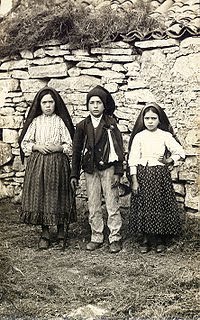 No
doubt many who read this will offer a sharp No! in answer to the first
question. (In case you're wondering I can't stand the picture left.)
But suppose you disagree with my judgment when I say that I think a work
of art is good - can we say who is right and who is wrong? If we look
to Church for guidance here it doesn't seem very helpful at first.
No
doubt many who read this will offer a sharp No! in answer to the first
question. (In case you're wondering I can't stand the picture left.)
But suppose you disagree with my judgment when I say that I think a work
of art is good - can we say who is right and who is wrong? If we look
to Church for guidance here it doesn't seem very helpful at first.The Church doesn't set out, to my knowledge, any hard and fast rules for what is appropriate style of imagery for our worship. This is a frustration to some, who wish that there were some so we could get rid of all the ugliness and sentimentalism. While to others it is their cue to allow just about anything into our churches and create the disaster of the last 50 years. If we lived in a time when the tradition of painting sacred art was still strong and living, then there probably wouldn't be any question in most people's minds, we would just happily and unquestioningly follow the current trend that and get on with it.
But we don't, and therefore in choosing images for the liturgy or for the 'domestic church' or prayer corner, there will be an element of personal taste involved. The fact that the Church does not stipulate a cannon of approved style leaves room both within existing traditions for personal responses and tastes, the flourishing of local variations and the possibility development of new styles that nevertheless sit within the bounds of what defines that tradition; and beyond that it also gives room for the development of styles that are so distinct that they would represent the establishment of a whole new tradition. I anticipate that any new style, perhaps one that marks our era, will start with one maverick artist who goes against the grain and who, it turns out, produces something that is recognised by those who choose art for our churches and other artists as capturing something that speaks to a particular need of the time.
This was recognised by Pius XII in Mediator Dei: 195. "Recent works of art which lend themselves to the materials of modern composition, should not be universally despised and rejected through prejudice. Modern art should be given free scope in the due and reverent service of the church and the sacred rites, provided that they preserve a correct balance between styles tending neither to extreme realism nor to excessive "symbolism," and that the needs of the Christian community are taken into consideration rather than the particular taste or talent of the individual artist. Thus modern art will be able to join its voice to that wonderful choir of praise to which have contributed, in honor of the Catholic faith, the greatest artists throughout the centuries. Nevertheless, in keeping with the duty of Our office, We cannot help deploring and condemning those works of art, recently introduced by some, which seem to be a distortion and perversion of true art and which at times openly shock Christian taste, modesty and devotion, and shamefully offend the true religious sense. These must be entirely excluded and banished from our churches, like "anything else that is not in keeping with the sanctity of the place."
Clearly from the latter part of the quote above, he is not saying 'anything goes' either. But how can we discern the difference? Freedom can be misused and so if we are going to look outside the traditions forms, we should be cautious. For the further we stray from traditional forms, the greater the chance of us mistakenly choosing the ugly, the superficial, the sentimental and the kitsch even if we can't see it ourselves. It is always worth taking into account that none of us should trust our taste absolutely - I therefore use the principle that in choosing art for public consumption, I will not stray outside the forms of the liturgical traditions of the Church. As NLM readers will know I accept the authority of Pope Emeritus Benedict when he states that there are three - the iconographic, the gothic and the baroque 'at its best' (the 17th century and extending further for some artists). In following this guidance therefore, we should not only be careful in accepting modern forms, but also those of the High Renaissance and naturalistic tradition of the 19th century (and artists such as Bougeureaux) which he does not include in his list of liturgical forms. Nevertheless, no one can rule out all artists from any particular era for even in the worst of times, there are likely to be individuals who are inspired and worthy of attention.
Let us suppose for a moment, though, that despite all of this I am drawn to something that is non-traditional and which, I am convinced, is good, true and beautiful nevertheless. How do I know I'm right and that this is an exception to the general guidelines given above? Every single one of us must be prepared to consider the possibility that to some degree at least, the judgments we are making are flawed. How can I tell? First of all I regardless of how much I like something I do my best to avoid anything that looks, very distorted and ultra modern in style - the chances are that these are not good for prayer. Similarly even if things seem skillfully drawn, if there is a sugary sentimentalism to the image or it looks 'kitsch' then avoid it. Then I find that asking the questions such as the following will help:
Does it reflect truth? Here I am considering if the content is reflective of what I know to be true. Does it conform to the gospel account of a scene, for example?
Is this beautiful? It might seem a statement of the obvious to put this in here, but it is surprising how often I might decide that I am drawn to something which I can't actually say that I think that it is beautiful.
Would I like to spend eternity with this? I got this question from a book by the architect Christopher Alexander who found that if you asked people for their preferences based upon different ways of asking the same question you got different answers. He found that because people have differing ideas of what constitutes beauty, you get less conformity of response than if you ask people to consider the same thing but by thinking about what the properties of beauty are. I thought this one was ingenious.
Do I like it? We don't want to eliminate personal taste altogether. Once I have got past the first set of questions then while these will not infallibly lead me to what is good and true and beautiful, it will at least increase the chances. Then I will choose something that I like. The good is, after all, the desirability of being and so at some level I have to think about how desirable something is if I am considering how good it is.
Bad or good? Bougeureau, Michelangelo and Botticelli from the 19th century and the Renaissance; and the 20th century artist Marc Chagall.













No comments:
Post a Comment